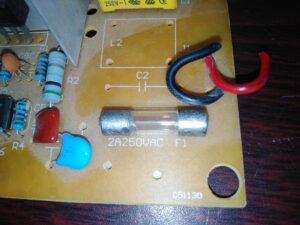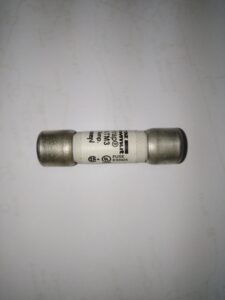In practical life as electrical engineers and electricians we, sometimes, inspect control circuits and distribution panels, and realize that AC fuses are used in DC circuits! It’s not that simple! Using an AC fuse in a DC circuit is a safety issue. Let’s find out why!
Table of Contents
What is a Fuse?
A fuse is a safety device used in electrical circuits to protect against overcurrent conditions. It consists of a thin wire or element that melts when current exceeds a certain value, breaking the circuit to prevent damage or fire hazards.
Fuses are designed to interrupt the flow of electricity when needed, serving as a critical component for circuit protection.
The fuse is a simple but important protection component. Many electrical devices use a fuse as a protection device.
Fuses are one-time-use protection devices, their filament link melts down in case of fault. This link is made of copper, Zinc, Silver, aluminum, or any other alloy having a predictable trip current.
AC Fuse vs. DC Fuse
AC (alternating current) and DC (direct current) are two different types of electrical currents, and they have some key differences that affect how fuses function in each type of circuit. Here’s a comparison of AC fuses and DC fuses:
-
Voltage Polarity:
- AC: Alternating current changes direction periodically, typically 50 or 60 times per second (depending on the region). AC voltage alternates between positive and negative values, meaning it has no fixed polarity.
- DC: Direct current flows in one direction consistently and does not change polarity.
-
Arcing Behavior:
- AC: AC voltage naturally crosses zero volts regularly during its cycle, which helps extinguish any arcs that may form when a fuse blows. The zero-crossing points in the AC waveform make it easier to interrupt the current and reduce the chances of sustained arcing.
- DC: DC voltage does not naturally cross zero, making it more challenging to extinguish arcs when a fuse blows. Arcs in DC circuits can be more persistent and dangerous.
-
Fuse Design:
- AC: AC fuses are designed to handle the periodic zero-crossing of the AC waveform. They have features to extinguish arcs, such as notches or special materials, that aid in interrupting the current.
- DC: DC fuses are designed differently, with features to handle sustained arcs more effectively. They may have larger gaps between the contacts and more robust construction to withstand the potentially higher energy associated with DC faults.
-
Ratings:
- AC: AC fuses are rated based on their ability to handle the peak voltage and current values of the AC waveform. Common AC fuse ratings are given in terms of amperes (A) and voltage (VAC).
- DC: DC fuses are rated based on the continuous and interrupting current capacity in a DC circuit. Common DC fuse ratings are given in terms of amperes (A) and voltage (VDC).
-
Compatibility:
- AC fuses are generally not suitable for use in DC circuits because they may not effectively interrupt DC currents and could pose a safety hazard.
- DC fuses can be used in AC circuits, but it’s essential to ensure that their ratings meet or exceed the requirements of the AC circuit.
The main differences between AC and DC fuses revolve around their ability to interrupt currents and extinguish arcs.
It’s crucial to use the appropriate type of fuse for the specific type of electrical circuit (AC or DC) to ensure safety and proper operation.
What will cause the arc to extinguish?
In the context of AC fuses, the intermittent zero-crossings in the AC current, which occur multiple times per second, play a crucial role in facilitating arc extinguishing.
In contrast, DC fuses face a greater challenge because the current remains constant without reaching zero.
To address this issue, DC fuses are deliberately designed to be longer compared to their AC counterparts. This added length serves to enhance the extinguishing of DC arcs.
can I use ac fuse for the dc circuit?
No, it is not advisable to use an AC fuse in a DC circuit, as it may not provide adequate protection and can pose safety risks.
AC and DC circuits have different characteristics, and their fuses are designed to operate in specific conditions:
-
Arc Extinction: AC fuses are designed with features that take advantage of the natural zero-crossing points in AC waveforms to help extinguish arcs when the fuse blows. DC fuses, on the other hand, are designed to interrupt DC currents effectively, which do not naturally cross zero. Using an AC fuse in a DC circuit may result in difficulties in extinguishing arcs, potentially causing damage or fire hazards.
-
Voltage Rating: AC fuses are rated for AC voltage levels, and their voltage ratings may not be suitable for DC applications. DC voltage can create arcing across the fuse contacts more easily, which can lead to the fuse not operating as intended and failing to protect the circuit.
-
Current Rating: While the current rating of a fuse is a critical factor, it’s important to use a fuse specifically designed for DC current interruption. DC currents can have different characteristics, and DC fuses are engineered to handle them safely.
To ensure the proper protection and safety of your DC circuit, always use fuses that are specifically designed and rated for DC applications.
Using an AC fuse in a DC circuit can result in unreliable protection and potential hazards.
Does Fuse Have a Positive and a Negative End?

Fuses do not have a positive or negative end in the same way that batteries or some other electrical components do.
Fuses are essentially safety devices designed to protect electrical circuits from overcurrent conditions. They are typically placed within a circuit to interrupt the flow of current when it exceeds a certain threshold, preventing damage to the circuit or potential fire hazards.
Fuses are usually installed in such a way that they interrupt the flow of current when the rated current is exceeded, regardless of the direction of the current flow.
This means that fuses are not polarity-sensitive; they work the same way regardless of whether the current flows in one direction (positive to negative) or the other (negative to positive) in a DC circuit or during the alternating cycle in an AC circuit.
Do All Fuses Do the Same Thing?
Yep, all fuses do the same protection task, overcurrent and short circuit protection. However, not all fuses operate the same way. The operation curve of the fuses is not the same. Besides, you should check the current and voltage rating of each fuse before using it to protect a circuit.
For instance, cars have DC fuses, each one has its own current rating to protect whatever it should protect.
A fuse serves as a sacrificial device, according to Little Fuse’s “Fuseology.” A conductive strip of material within a fuse, commonly known as its “breaking capability” melts if the Fuse is overloaded.
When a system overloads or shorts, the Fuse protects the more extensive system by breaking the circuit or “opening”.
Can Fuse Protect Against High Voltage?

Fuses primarily protect against excessive current, not high voltage. Their main purpose is to break the circuit and stop the flow of current when the current exceeds its rated value. This is essential for preventing overheating of wires, components, and potential fire hazards caused by overcurrent conditions.
However, fuses are not designed to provide protection against high voltage levels on their own. They do not have a specific voltage rating like some other electrical components (e.g., capacitors, resistors). Fuses are rated in terms of current (amperes) and are selected based on the current-carrying capacity required for the circuit they are intended to protect.
It’s crucial to select a fuse with an appropriate current rating for your circuit to prevent overcurrent situations.
If you need protection against both high voltage and high current, it may be necessary to incorporate other protective devices like circuit breakers or surge protectors into your electrical system, as these can provide voltage and current protection depending on their design and purpose.
Does Voltage Affect a Fuse?
Yes, Of course, voltage affects a fuse, and the specified Fuse’s voltage rating must be more than or equal to the circuit voltage. Fuses are connected in series in the circuit so, the voltage rating is only relevant while the Fuse is attempting to open.
Voltage plays a significant role in the performance of fuses. The voltage rating of a fuse must always be equal to or higher than the circuit voltage it is meant to protect.
The critical function of a fuse is to open quickly when exposed to excessive current, extinguish any resulting arc, and prevent the open-circuit voltage in the system from striking across the open fuse element.
While the fuse links themselves are not inherently voltage-sensitive devices, their ability to function correctly during fault situations can be influenced by the system voltage.
Consequently, it’s essential to use fuse links in circuits with voltages that do not exceed their rated voltage to maintain effective arc suppression and circuit protection.
Read also my article, What is Overcurrent Protection.
Is It Normal for A Fuse to Get Hot?

No, it’s not normal for any fuse to get hot. You shouldn’t ignore this if your fuses get hot.
A current much below the fuse rating might create enough heat to melt an inline fuse holder if there is substantial resistance in the contact between the Fuse and the fuse holder.
While the initial resistance may be more minor, and the first heating may not be sufficient to reach the fuse melting point, the heat might produce oxidation of the metal connections, increasing contact resistance.
What Causes A Fuse to Get Hot?
- Overloading the fuse causes it to get hot, if the fuse curve is a slow one, it may get hot for a while before it opens the circuit.
- Bad contact between the fuse holder and the circuit causes hot spots. This issue is repeated in my workplace’s 11KV overhead power line.
- Corroded connections, wiring, or a device that is beginning to malfunction and impeding normal current flow are all causes of high resistance that can cause heating fuses.
What Are the Standard Fuse Sizes?
In the 2017 NEC, the paragraph was turned into new Table 240.6(A), Fuse and fixed trip circuit breakers are available in the following sizes: 15, 20, 25, 30, 35, 40, 45, 50, 60, 70, 80, 90, 100, 110, 125, 150, 175, 200, 225, 250, 300, 350, 400, 450, 500, 600, 700, 800, 1000, 1200, 1600, 2000, 2500, 3000, 4000, 5000, and 6000 amps, instead of these Additional standard fuse sizes are 601 and 10, 6, 3, 1 amp.
Should the Fuse Be on a Positive or Negative Terminal?
Fuses are typically installed in electrical circuits on the positive side (anode) of the circuit, but this can vary depending on the specific application and design of the circuit.
The choice of whether to place the fuse on the positive or negative terminal depends on several factors, including safety considerations, circuit design, and common practices in the industry.
Here are some general guidelines:
- Positive Side (Anode): This is the more common placement for fuses in most circuits. Placing the fuse on the positive side of the circuit allows for easier visual inspection, as it is often the side where power enters the circuit. If the fuse blows, it interrupts the flow of current from the power source to the load, effectively disconnecting the circuit.
- Negative Side (Cathode): In some cases, especially in high-power or high-voltage applications, fuses may be placed on the negative side of the circuit. This can help reduce the risk of arcing and damage on the positive side when a fuse blows. It also ensures that the load is disconnected from the power source when the fuse opens.
Ultimately, the choice of whether to place the fuse on the positive or negative terminal should be based on safety considerations and adherence to the specific design requirements of the circuit.
It’s essential to follow the manufacturer’s recommendations and industry standards when determining the fuse’s placement within the circuit to ensure safe and effective protection.
Install my Free Android App on Google Play:
Electrical Cables Most Common Tables “Electrical Cables Tables”
And, my Electrical Calculations App “Fast Electrical Calculator”
Discover more great content by subscribing to My channel
Looking to stay ahead of the game in the world of electrical engineering? Subscribe to my YouTube channel and gain access to exclusive content you won’t find anywhere else!
The staff I recommend
(Amazon Affiliate Links to products I believe are high quality):
- Economy 120 Volt/60Hz AC Power Source – Step-Down Voltage & Frequency Converters 1800W
- UNI-T Digital Multimeter Tester UT139C
- 50-Amp Extension Cord for RV “100ft”
- Voltage Stabilizer 110/220v
- Hair Dryer “best selling“
- TOSHIBA EM131A5C-BS Countertop Microwave Ovens
Disclaimer: This contains affiliate links to Amazon products. I may earn a commission for purchases made through these links.


